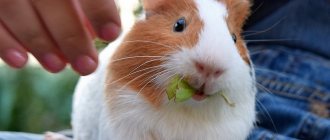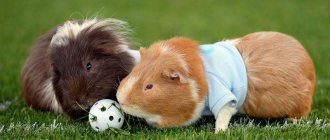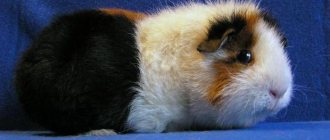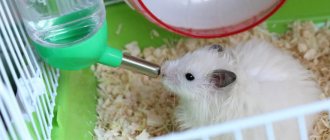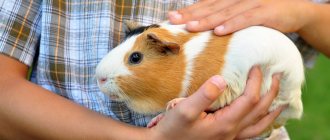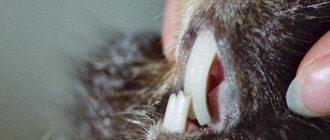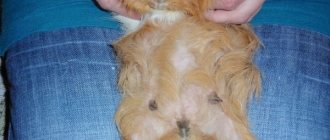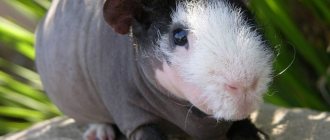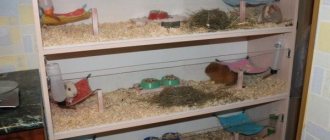The body structure of decorative cavy differs from its wild counterparts in the width and roundness of its shape. The normal weight of a guinea pig depends on gender and breed. Males are larger than females, by about 20-25%.
The limits to which guinea pigs grow are influenced by genetics and the conditions in which the animal grew up and is kept. Monitoring the dynamics of parameters and comparison with the norm helps to monitor the health of the pet.
What types of guinea pigs are there?
There are several organizations in the world that set standards for rodents. We will focus on the classification Standard for the judging of all cavy breeds as recognized by the European Association of the European Association of Breeders of Poultry, Pigeons, Ornamental Birds, Rabbits and Guinea Pigs.
Pets come in different colors: white, red, cream, black, chocolate and more. There are also spotted individuals. The eyes are black, pink or dark ruby.
Experts divide guinea pig species into three groups based on their coat structure.
Wire-haired guinea pigs
This category includes six species of animal.
- Satin . The rodent's fur is thick and short. Hair shines thanks to its special structure. Their color can be any.
- Crested . The body is covered with smooth and short fur. There is a tuft on the forehead. It is sometimes called a rosette.
- Rex. Rodents have elastic, corrugated fur that stands up straight. The hairs are short and rough to the touch. The mustache is curly.
- Abyssinian. The body is evenly covered with “rosettes”; there can be 10–12 of them. The length of the coat is approximately 3.5 cm.
- American Teddy. The fur is plush and soft. The length of the hairs is at least 2 cm. The belly of young individuals is curly, but this goes away with age. The mustache is straight.
- Swiss Teddy. The wool is rough and crimped. Its length on the body reaches 6 cm. With light contact, the hairs should show elasticity and return to their previous appearance. The mustache is normally wavy.
Abyssinian guinea pig. Photo: Tettania / Shutterstock
Long-haired guinea pigs
There are seven varieties in this category.
- Peruvian. These guinea pigs have very long and soft fur. The bangs completely cover the muzzle.
- Sheltie. The hairs on the animal's head are short. Longer ones start on the cheeks and behind the ears. They grow from the muzzle and form a mane. The fur is silky to the touch.
- Coronet. There is a tuft on the forehead. The hair on the body is long, elastic and soft.
- Alpaca. The rodent has two “rosettes” on its back. The fur is curly. The mustache is normally curly.
- Texel. Long curls on the body. They are directed from the head to the sacrum. The hair on the face is short and crimped.
- Merino. There is a rosette on the animal's forehead. The head is smooth-haired. The longer fur starts behind the ears.
- Lunkaria. The coat is curly and harsh. This makes such a guinea pig look like a sheep. There are two “rosettes” on the sacrum.
Guinea pig coronet. Photo: Pernille Westh/Shutterstock
Smooth-haired guinea pigs
These animals have short and shiny fur. It grows from the head to the back of the body. The length of an individual hair is slightly more than 2 cm. Varieties of rodents differ in color, which are divided into several groups.
- Plain. The body, belly, paws and muzzle of the rodent are covered with fur of the same color.
- Agouti. The animal's fur throughout the body, except the belly, is ticked. This means that each hair has alternating areas of different colors.
- Total agouti. It differs from the previous type only in that there are ticked hairs even on the belly.
- Argent. Guinea pigs with this color also have ticked fur on their bodies. There are no two-color hairs only on the abdomen. The main feature of the variety is dark ruby or pink eyes.
- Labeled . Areas of fur differ from each other in different colors.
Smooth-haired guinea pig with marked color. Photo: Robirensi/Shutterstock
Periods of growing up
Theoretically, the life cycle of the animal can be divided into 4 stages. Normal indicators such as size and weight may vary depending on the breed, but the rate of development is identical for all animals of this species.
- Child stage – 0–3 months;
- juvenile stage – 3 months. – 1.5 years;
- maturity – 1.5-5.5 years;
- old age – 6 years and above.
During childhood, pets grow quickly. On average, the normal weight of a newly born pig is from 50 to 140 grams. These data are influenced by the age of the mother, living conditions during gestation, and how many pigs are in the litter. Most often, the largest animals are those that are among the first born in the litter.
By the beginning of the fifth week, the pet’s height is 19 centimeters. At this time, it is best to purchase a guinea pig, because at this moment the pets are almost independent and are ready to leave their mother. At 2 months, the normal weight indicator is on average 350–400 grams.
Females reach sexual maturity by the 30th day of existence, and males by the 70th day. The animals are interested in the opposite sex and are capable of reproduction. It is better not to kill rodents at such a young age, because their body has not yet fully formed.
In adolescence, the pet shows curiosity towards the opposite sex; by three months the difference in the size of the pigs becomes clearly noticeable. An individual at this time can weigh ten times more than it weighed when it was born.
The body stops forming by the sixth month. The guinea pig can already perform reproductive functions. The growth rate drops noticeably.
The pet becomes fully adult at 15 months. Until this time, he increases height and weight parameters. The weight of an adult guinea pig is 700 grams or more.
The average lifespan is 6 to 8 years. From the age of 4, the body undergoes age-related changes. By age 6, your guinea pig's weight may begin to drop. The reproductive function is impaired, and problems with food processing begin. The aging process can be seen visually by the condition of the coat and activity.
What is the character of guinea pigs?
A guinea pig bonds with Guinea Pig: Species Profile to a person who takes care of it regularly. Many animals enjoy cuddling with their owners. Some individuals even begin to squeal with excitement when they see loved ones.
Like any pet, a rodent can sometimes get nervous. It rarely bites. If you play with him often, he will get used to it and will feel comfortable in a person's arms.
When exposed to other species, your guinea pig may panic. Special Considerations for Guinea Pigs. Therefore, keep her away from cats, dogs and other animals. This will also help prevent the spread of infections.
Remember: the company of people will never replace the company of animals like themselves. Therefore, it is recommended that Guinea Pig: Species Profile keep pets in pairs.
If you do not intend to breed guinea pigs, consider purchasing two of the same sex. It is believed that females are the best option. Males, especially those who are not castrated, sometimes fight.
Unlike rats and hamsters, guinea pigs are diurnal Special Considerations for Guinea Pigs. Therefore, at night they do not disturb their owners’ sleep.
The main mistakes in caring for land turtles
Follow the rules of care and then your pet will delight you with its good mood and health
People often buy turtles without thinking about the care they require. The most common mistakes in keeping reptiles:
- Lack of a terrarium as such. Unfortunately, most people buy reptiles, forgetting about the arrangement of their habitat. They let them crawl around the house, without providing any temperature control or other comfortable living conditions for the pet.
- No UV lamp. Not all owners are aware of the extreme necessity of ultraviolet radiation for the health of their pet. If there is no such lamp, problems arise with the baby’s shell and health.
- Cleaning your pet with a stiff brush when shedding. Bathing should not be accompanied by any additional cleaning products or brushes. After bathing, wipe dry with a soft towel.
- Keeping several pets in one terrarium. Doing this is strictly prohibited. Two males in the same area or animals of different sizes will definitely start a war for territory.
- Washing the terrarium in the sink with kitchen utensils. It’s best to do all the cleaning outside of the kitchen. The use of a kitchen sponge is also undesirable for hygienic purposes. It is better to prepare a separate set of rags and sponges for cleaning the animal’s home, and after this procedure, thoroughly disinfect the sink.
Wash your hands thoroughly with soap!
The turtle is a wonderful, unpretentious pet. With proper care and feeding, he will delight his owners for many years. Many people love to watch their pet bask in the sun and take it with them to the dacha for a walk on the grass. And for some, arranging a reptile’s place of residence turns into a real hobby. If you don’t want to waste time on walks and constant fussing with the animal, a turtle is the best choice to purchase.
What living conditions do guinea pigs require?
These are active animals, so they need a lot of space. It is best to place the rodent in a spacious cage. How to set up a Guinea Pig cage. The minimum floor area for one individual is 90 × 70 cm, for two - 120 × 70. The height of the home is 45 cm. Then the guinea pig can easily stand on its hind legs.
The bottom of the cage should be hard and smooth, for example plastic. The pet can damage its paws on the slatted floor. The walls of a good house are made of twigs: this ensures normal air circulation.
The How to Set Up the Perfect Guinea Pig Enclosure should not be placed in a draft, near radiators or in direct sunlight. The ideal temperature Special Considerations for Guinea Pigs in the room where rodents live is 18–23 degrees. If it rises above 29 degrees, your pet may suffer from heatstroke. Also try to maintain relatively low air humidity - up to 50%. The area around the cage should be quiet Guinea Pig: Species Profile. Loud noises and sudden movements often cause stress in guinea pigs.
What Do Guinea Pigs Need In Their Cage? nipple drinker. It is also worth buying ceramic bowls. Animals easily turn over plastic dishes.
Photo: Elena Sineglazova / Shutterstock
There should be enough shelters How to set up a Guinea Pig cage in the home so that all the guinea pigs can hide at the same time. Tunnels, houses or pipes will do.
How To Set Up A Guinea Pig Hutch bedding is usually placed on the floor of the hut. You can use paper or fleece. If you want to stick with pellet wood filler, choose aspen. It will absorb the animal's urine well. It is not recommended to buy cedar and pine shavings from Guinea pig housing. When wet, it sometimes releases vapors containing substances that irritate the animal's respiratory tract and paws. Straw won't work either. It can injure your pet's eyes.
Natural size of a rodent
In nature, the appearance of wild pigs only vaguely resembles decorative domesticated rodents. Nimble, agile and with a strong muscular body, the animals have been looking for food for centuries and trying to hide from birds of prey and animals, and from people who have discovered the taste of a new type of meat.
Article on the topic: Anatomy and skeleton of a guinea pig, internal and external body structure
Despite its light and graceful body structure, the wild pig is hardy and adapted to long runs in search of food . An oblong body with a short neck and legs seems designed to flow among stones and seek shelter in underground tunnels.
Despite the small size and graceful forms of the wild pig, there are real giants among its relatives:
- Moko is a rock pig. It is larger in size than a guinea pig and weighs up to 1 kilogram.
- Agouti - the body of the animal grows up to 50 cm, and weight up to 4 kg.
- Pack - body about 40 cm, weight 10 kg.
- Mara is a rodent belonging to the half-ungulate family. The length of the body reaches 70 centimeters, and the weight is up to 16 kg.
- Pacarana is an animal up to 80 cm long and weighing up to 15 kg.
- The capybara is the largest rodent. The length of the body is 1.3 meters, and the weight is 50 kg .
Since wild animals have been hunted since ancient times, in order to maintain the population, wild species of rodents were forced to interbreed, and there were no purebred pigs left among them. This is confirmed by the range in size of pets, from 15 to 30 cm. Selection has also borne fruit. The domesticated pig lost its tail, but acquired a pleasant rounded shape and relatively larger size than the wild specimen.
What to feed guinea pigs
Guinea pigs are herbivores. The majority of their daily diet should be Feeding Guinea Pigs hay. A mixture of timothy and oats works best. Alfalfa should be given in small quantities. There is too much calcium in this grass.
If you throw food on the floor of your home, it will mix with the animal's feces. Therefore, some owners buy a hay box that is attached to the bars of the cage.
Photo: jessehr/Depositphotos
It is important that the hay is always fresh Feeding Guinea Pigs. Anything that smells musty should not be given. To prevent it from becoming moldy, you need to choose a storage place. A cool, dry environment is suitable.
You can't do without hay. What should I feed my guinea pigs? . It helps the guinea pig's intestines work properly. The rodent also wears down its teeth, which grow throughout its life.
In addition, vegetables and fruits should be included in the guinea pig's daily diet. This food is a good source of vitamin C. Here are some Feeding Guinea Pigs examples of what you can feed your animal:
- bananas;
- blueberry;
- cantaloupe;
- green peppers;
- strawberry;
- tomatoes;
- watermelon.
There should be more vegetables in a rodent's diet than fruits. All products should first be washed and cut into small pieces. After this, they can be placed in a bowl. If the treat is not eaten within a few hours, it should be thrown away. Rotten food What should I feed my guinea pigs? will only harm the guinea pig.
The animal also needs to be given greens and grass. Lettuce or dandelion leaves, marjoram, arugula, calendula, rosemary, dill, parsley, basil, and carrot tops are suitable.
Guinea pigs can also be fed special granulated food. Make sure the fiber content is at least 16%. But you shouldn’t make the ready-made mixture the basis of your diet.
A rodent should be accustomed to any new foods gradually. Increase the number of treats over two weeks. This will give the digestive system time to adjust and prevent the animal from getting sick.
Some foods seem harmless, but you should not give them to your animal. This is what causes serious What should I feed my guinea pigs? health problems:
- cereals;
- grains;
- nuts;
- seeds;
- dried beans;
- corn;
- buttercups;
- lilies;
- acorns and oak bark;
- avocado;
- rhubarb;
- onion;
- potato tops;
- mushrooms;
- bread;
- cookie;
- chocolate;
- pasta;
- pickled vegetables.
Make sure that the rodent has fresh water around the clock.
How to care for a guinea pig
Unlike dogs and cats, rodents require minimal care. There are several Grooming Care for Your Guinea Pig tips that will help make your pet's life more comfortable.
Trim your nails
The procedure is performed on all guinea pigs. The frequency depends on the rate of claw regrowth. In young individuals with a balanced diet, this happens faster than in older ones. For trimming, you will need special nail clippers; you can buy them at a pet store.
To do everything correctly, look at the claw in the light. You will see a translucent tip, you need to cut it off. Just above the process is the pink part. There are blood vessels there, you can’t touch them. If this does happen, take a paper towel, place it on the wound and press it for a few minutes.
The procedure can be carried out conveniently by two people. One person holds the pet by the stomach and presses it tightly to his body so that the paws do not dangle. The second one cuts his claws. If there is no one to help, the owner can wrap the guinea pig in a towel and hold it under one arm. The fingers remain free.
If the animal is nervous, you should interrupt the procedure and continue later. But most rodents still tolerate having their nails trimmed when they are distracted by food.
Get out of the cage
The pet needs cleanliness. If the home is dirty, the animal may develop How to Clean a Guinea Pig Cage respiratory disease.
Every day, remove those parts of the litter that have already absorbed urine. Then add fresh one. You can use a small spatula.
Once a week, remove shelters, bowls and water bottles from the cage. Treat them with a non-toxic cleaner from a pet store. Wipe down the house itself. Replace all filler with fresh one.
Comb the animal
Rodents with short hair are brushed with Grooming Care for Your Guinea Pig with a soft brush once a week. This keeps shedding to a minimum. Inspect the rodent during the procedure. If you notice ticks, fleas, scratches or scabs, you should contact your veterinarian.
Long-haired pigs are brushed several times a week. This helps avoid tangles. Fine-tooth combs work best for this.
Bathe occasionally
Let's say right away that they bathe the animal only in extreme cases. Grooming Care for Your Guinea Pig. For example, if your guinea pig gets dirty due to diarrhea. In such a situation, the contaminated area should be washed with warm water and animal shampoo. After this, pat the wool dry with a towel.
Description of the animal
If you decide to buy a pet for your child, but don’t know which one to choose, buy a guinea pig.
A friendly, sociable, unpretentious rodent is quite easy to keep, and caring for it will help the child become neat, disciplined and caring. Among the representatives of the breed, of course, there are individuals who can bite, but in general, aggressiveness is not inherent in pigs. However, this does not mean at all that the Kavya will rush into the arms of its new owner on the very first day, trustingly clinging to him.
Pigs are shy! They will be wary of everyone for some time.
It must also be remembered that pigs do not have a high level of intelligence. They will not play with your child the way a cat or dog would, and it will be impossible to get her to obey in everything. But they can remember their nickname, and even respond to it.
Cavia is a talkative creature. It is capable of producing many sounds, not all of which are pleasant to the human ear. The pet can be intrusive and extremely noisy in those moments when it requires treats or attention to itself.
The pig is a big fan of running outside the cage. It is recommended to release them once a day. At the same time, you need to keep an eye on the kids, as they can hide in such a way that it will take a long time to look for them. Or they can easily interrupt your connection with the outside world by gnawing wires from your phone or Internet.
If you decide to let your rodent run free on your lawn, you need to watch it especially carefully. Despite its bright color, the pig hides very well in the grass, often becoming prey for dogs.
If in the wild a pig encounters a threat previously unknown, it will certainly freeze and will remain so until the threat disappears.
An older child can handle mumps, but you still shouldn’t trust it to tiny kids. Even a fall from a small height can be fatal for a pet.
During the breeding season or during illness, pigs are not particularly stable. There are cases when they even bit the owner.
A baby living in the house may sometimes suffer from parasites such as fleas, ticks and worms. The most common mite is the scabies mite.
If mumps is not treated, everything can end very sadly.
The following symptoms will help you understand that something is wrong with your pet:
- runny nose;
- tousled fur;
- festering eyes;
- skin ulcers;
- very dry or, conversely, frequent and loose stools;
- labored breathing;
- uncharacteristic behavior in general.
And if the temperature rises above 39 degrees, this should be a signal for an urgent visit to the veterinarian.
Despite the fact that guinea pig owners are often skeptical about the vaccination procedure, veterinarians still recommend vaccinating their pet to protect it from the most common diseases.
The advantages of the content include the following:
- ease of care;
- mumps does not create any particular difficulties in the matter of feeding;
- does not require much space;
- does not need walks;
- has good health;
- distinguished by longevity.
We invite you to read: Lop-eared sheep rabbit: description of the decorative breed, how long they live, sizes, how to care for them, photos
Cons of the content:
- can show its character;
- rodents spoil things if left unattended outside the cage;
- long-haired breeds require grooming
What do guinea pigs get sick of?
The condition of the animal must be monitored. Sometimes rodents develop such abnormalities Common Guinea Pig Illnesses.
Diarrhea
It may appear due to a bacterial infection of the intestine or when the animal eats a lot of watery foods. In any case, you need to remove fruits and vegetables from your guinea pig’s diet and add hay. Then the rodent should be taken to the veterinarian.
Dental problems
As we have already said, a rodent's teeth grow throughout its life. If the animal doesn't wear them well, they can become too long. Because of this, some individuals begin to refuse food. Check your guinea pig's mouth every week to help identify problems early. As a preventive measure, you can give your animal chewing sticks from a pet store. In advanced cases, the teeth are trimmed by a veterinarian.
Ticks
Some penetrate the skin and cause irritation. The animal begins to itch. Because of this, the skin turns red and the hair falls out. Recommendations for treatment are given by a veterinarian. Regardless of the remedy that the doctor recommends, the owner must clean the cage. This will help avoid problems in the future.
Respiratory infections
Pneumonia or other illness may occur due to too humid air. The deviation is easy to recognize: the animal wheezes and seems lethargic. These symptoms are a reason to consult a veterinarian as soon as possible.
Scurvy
The animal may lose weight. Sometimes diarrhea and problems with the musculoskeletal system appear. To help the rodent, experts recommend introducing additional foods and vitamin C supplements into the diet.
Cystitis
Females are especially prone to the disease. The abnormality can be noticed by blood in the urine. Sometimes guinea pigs stop urinating completely, so it is important to monitor the litter in the cage.
What to look for when buying a guinea pig
The animal can be purchased at a pet store, nursery or from a breeder. Before picking up your pet, check Guinea Pig: Species Profile for the conditions and health of the individual.
Make sure males and females are in separate cages. If they are kept together, you can bring home a pregnant guinea pig.
Observe how the animal you like behaves in the house. Normally he is active and alert. Pick up the rodent and examine it. When everything is good, the fur is clean and without bald spots. There are no redness or scales on the skin. There is no fluid leaking from the ears, eyes, nose or anus. The body is round and strong.
If the animal seems too quiet, refuse the purchase. Your guinea pig may be sick.
Breed
The size of guinea pigs largely depends on the breed. During the selection process, individuals of different heights and weights were crossed, so both miniature and large animals are found. The following breeds of domestic guinea pigs have the largest dimensions:
- Abyssinian;
- coronet;
- tortoiseshell;
- English Rex;
- Ridgeback;
- Teddy;
- kui;
- Himalayan;
- Peruvian.
These animals often reach weights of more than 1–1.5 kg.

